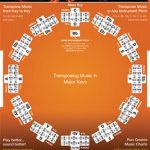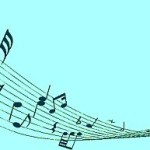Hey fellow musicians… Ron Greene here,
There are a lot of decent basic music theory books, tapes etc. on the market these days, and many of them provide good technical content. However, most of the information in them seems to lack specific details that otherwise, really never get you to the point of playing your instrument.
For example, this free music theory publication does a good job of explaining Key Signatures and the history of music, yet, this subject might not interest you as much as getting your instrument out and actually getting down to the matter at hand… playing it!
I’ve been playing musical instruments since 1963. Around 1987 I discovered something very interesting… a large ‘gap’ in music theory lessons and instructional programs. I could not locate any products on the market that would support my ability to grow with my instruments in an easy format.
So… what did I do?… I spent the late 80’s mind-storming ways to come up with an idea that would assist existing and beginning musicians with the ability to quickly and easily expand on their musical skills while making music theory fun at the same time.
 Prototype after prototype emerged. For three years straight my basement looked like something from Frankenstein meets Thomas Edison. Always looking for better ways to understand and apply musical insights. Then, in 1991 I finally hit on the idea of the Music Dials. After years of experimentation the inspirational flash I was searching for streaked across my brain in an instant. All of my prototypes came together at that moment. The thought of having “all” references to music theory… like; chord structures, melodic notes, scales, all-in-one handheld device (dial) was born! Hence the Music Dial.
Prototype after prototype emerged. For three years straight my basement looked like something from Frankenstein meets Thomas Edison. Always looking for better ways to understand and apply musical insights. Then, in 1991 I finally hit on the idea of the Music Dials. After years of experimentation the inspirational flash I was searching for streaked across my brain in an instant. All of my prototypes came together at that moment. The thought of having “all” references to music theory… like; chord structures, melodic notes, scales, all-in-one handheld device (dial) was born! Hence the Music Dial.
Recently, an associate of mine videoed me talking about how the Music Dial as they relate (among other musical techniques) to basic music theory. If you are interested, give it a look see… it’s only 4 minutes in length.
What I’ve tried to deliver in the development and construction of the Music Dials, is the ability to provide you with a means to show you the forms, (scale and chord positions) on your fret-board for string instruments – and keyboard locations for piano players, visually, right in front of you.
You’ll immediately notice a difference in how you learn music theory using the Music Dials. It’s what I call “implied” or “applied” music theory. Meaning, while you play your instrument you are consciously and sub-consciously learning insightful basic music theory information, naturally. And indeed, you’re having the enjoyment of playing your instrument at the same time.
All songs are played in a key. Most songs for most styles can be played using only 8 chords for accompaniment and 6 scales for melodies or solos in each key. My Music Dials instantly show you the chords & scales you need in each key. The 8 chords in each key you should and will know…
The 6 common chords come from the major scale notes in each key and are called scale tone chords (I = do, IIm = re, IIIm = mi, IV = fa, V = so, VIm = la).
The 2 optional chords (bIII, bVII), commonly used for rock & blues, come from the flatted third and flatted seventh (notes of the major scale and can also be used to play songs in each key.)
Except for jazz, most songs use only major, minor, and seventh chords and these are the basic chords you should learn in each key. Experiment with and have fun playing, creating, or improvising great-sounding chord progressions in each key.
There are four chord types: major, minor, augmented, diminished. There are many extensions of these chord types including; suspended, fifth, sixth, seventh, ninth, eleventh, and thirteenth chords. Chord formulas define which major scale notes are contained in the chord (1 = do, 2 = re,3 = mi, 4 = fa, 5 = so, 6 = la, 7 = ti). Below are the formulas for the 4 chord types and their extensions:
The specific scale you use to play solo in each key depends on the type of sound you want to create. Here are the 6 most commonly used scales including 2 for “melodic” sounding solos, 2 for “blues” sounding solos and 2 for various other sounding solos.
 Scale formulas define which major scale notes are contained in the scale (1 = do, 2 = re, 3 = mi, 4 = fa, 5 = so, 6 = la, 7 = ti).
Scale formulas define which major scale notes are contained in the scale (1 = do, 2 = re, 3 = mi, 4 = fa, 5 = so, 6 = la, 7 = ti).
The Music Dial instantly shows the formulas for the 6 scales, making music theory easy to learn as a natural relationship to your musical instrument playing.
< Grab this free musicians’ reference booklet PDF to learn more.
I hope this section has shed some light on music theory and how the Music Dials could assist with your resolve to play better, whether you are a guitar player, bass guitar player, Keyboard player, mandolin or banjo player, or any instrument for that matter (like horns, etc.).
Music Theory Demystified
Music theory is a vast and complex subject, and there is much more to it than can be covered in a single article. However, understanding the basic concepts of pitch, melody, harmony, form, and rhythm is essential for any musician. It helps to provide a foundation for further study and helps musicians communicate about and analyze music. Whether you are a beginner or an experienced musician, studying music theory can help deepen your understanding and appreciation of music.
I look forward to providing more tips on playing better musically with your instrument(s) in all of our following blog postings. Let’s venture into how “Playing by Ear” soon, as it relates to playing music.
Have a great musical day!
Ron Greene
Be sure to read more about music theory with this free information, here…
https://musicdials.com/music-theory/

